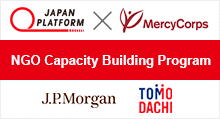◆◆ J.P. Morgan & TOMODACHI Initiative X Mercy Cops & Japan Platform ◆◆
MC-JPF Humanitarian Response Workshop 2015
-Helping to Save Lives and Protect People-
at Mercy Corps HQ, in Portland, Oregon, U.S.A.
November 30 - December 4, 2015
Event Report
Select each report below to read the voice of each participant.
How Shall It Be?
We are stretched
In winter's cool air
There is tension
And no easy matters
In humanitarian assistance
Before the workshop, we must have completed the Pre-Course Work that required 60 hours to do even for native English speakers. I completed it in 120 hours. The workshop started with both of anxiety and excitement.
The introduction among participants took place by interviewing with each other based on a questionnaire. It was a good experience to communicate with each other.
For the first item of the workshop, MercyCorps' staff shared their experience of Humanitarian Context and Humanitarian Principles mentioned in the Sphere Project(*1). We realized that it was difficult to perform humanitarian missions along with them. In particular, we realized it was very difficult to perform humanitarian assistance impartially in Syria. It is important for all people on the earth to share the problems in Syria and address these.
Dr. Tomoaki Natsukawa
Humanitarian Medical Assistance (HuMA)
*1 The Sphere Project (Sphere):
In the aim of improving the quality of humanitarian agencies' actions during disaster response and to be held accountable for them, a group of NGOs and the International Red Cross and Red Crescent Movement established a set of standards in core areas of humanitarian assistance being based on the Humanitarian Charter.
http://www.sphereproject.org/about/
Sessions for the Morning in Day 1:
- Objectives/Agenda/Methodologies/Introductions
- Explanation of Humanitarian Exercise
- Introductions of participants
- Recommendations for Engagement
- Provide a security briefing about Portland, building, etc
- The Humanitarian Context
- Humanitarian Principles
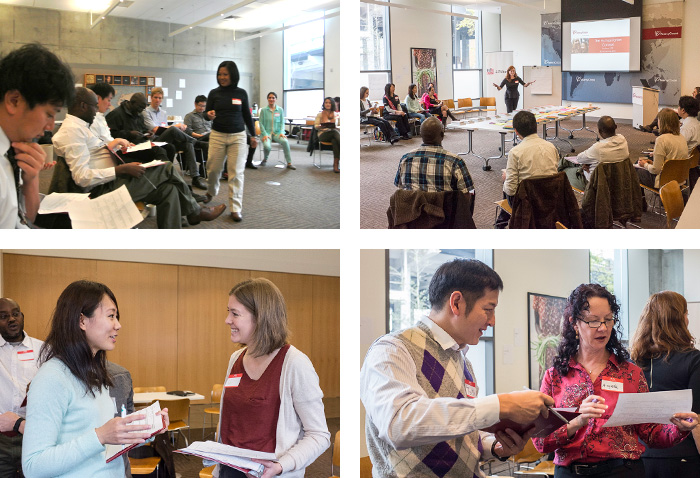
Next:"The Day 1 Afternoon: Follow Your Inner Voice - Mototaka Inaba, HuMA"
Follow Your Inner Voice
We learned about "Stress Management" and "Humanitarian Responder" in this afternoon.
It was very interesting to know that many aid workers bring accessories for themselves to relax (for example, music, books, exercise equipments...).
But sometimes, to relax in the field and safety management can be a contradictory concept. So I felt the balance between them is important if I lead the field.
One facilitator said, "In the field, we have to handle many tasks at a time so we need to prioritize the things to do. It may be difficult, but at the end of the day, follow your inner voice." The message was very impressive.
Dr. Mototaka Inaba
Humanitarian Medical Assistance (HuMA)
Sessions for the Afternoon in Day 1:
- Humanitarian Principles (continued from the morning session)
- Your Inner Context
- Safety and Stress Management
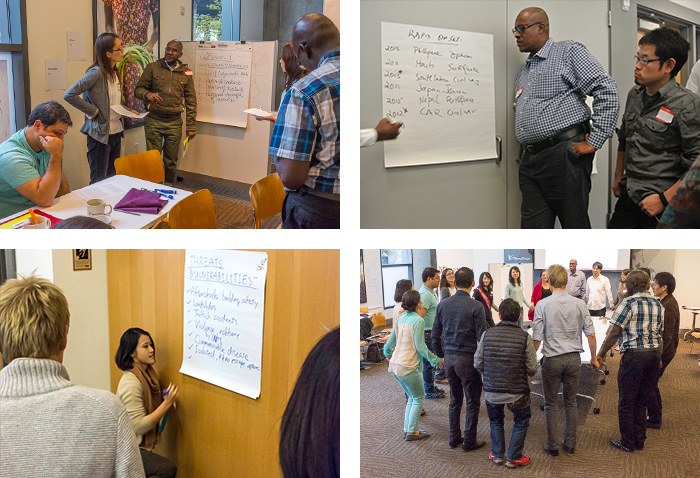
"The Day 2 Morning: Unite Efforts and Save the Affected People - Kimiko Yamashita, HuMA"
Unite Efforts and Save the Affected People
In the morning of the second day, we received three lectures about the basics of humanitarian activities such as the Humanitarian Program Cycle(*1), coordination among the clusters(*2) and funding mechanism. All of these are as necessary as the themes learnt on the day before. The common goal of these lectures is to provide seamless and fast assistances to the affected people in a coordinated way among various humanitarian agencies. Only one person or only one agency cannot do everything by themselves, and they sometimes concentrate too much on what they can do, and they could not notice the other parts of clusters. We should try to have wider perspectives and unite efforts with various aid workers. Furthermore, it will make easier to collaborate if each individual acquires common language as the Sphere Project(*3), the Code of Conduct(*4) and so on.
Dr. Kimiko Yamashita
Humanitarian Medical Assistance (HuMA)
*1 The cycle of humanitarian planning:
The way in which humanitarian actors work together to help people affected by disasters and conflict. It consists of five elements coordinated in a seamless manner, with one step logically building on the previous and leading to the next. Five elements are needs assessment & analysis, strategic response planning, resource mobilization, implementation & monitoring, and operational review & evaluation.
*2 Clusters
A cluster is a group of agencies that gather to work together towards common objectives within a particular sector of emergency response. The cluster approach is an important step on the road to more effective humanitarian coordination. Ultimately the cluster approach aims to improve the predictability, timeliness, and effectiveness of humanitarian response, and pave the way for recovery.
*3 The Sphere Project (Sphere):
In the aim of improving the quality of humanitarian agencies' actions during disaster response and to be held accountable for them, a group of NGOs and the International Red Cross and Red Crescent Movement established a set of standards in core areas of humanitarian assistance being based on the Humanitarian Charter.
http://www.sphereproject.org/about/
*4 The Code of Conduct:
It is placed as an essential in the Sphere Project handbook and seeks to guard our standards of behavior.
Sessions for the Morning in Day 2:
- Review of Day 1
- Humanitarian Program Cycle and Assessments
- The Cluster System
- Humanitarian Funding Mechanisms
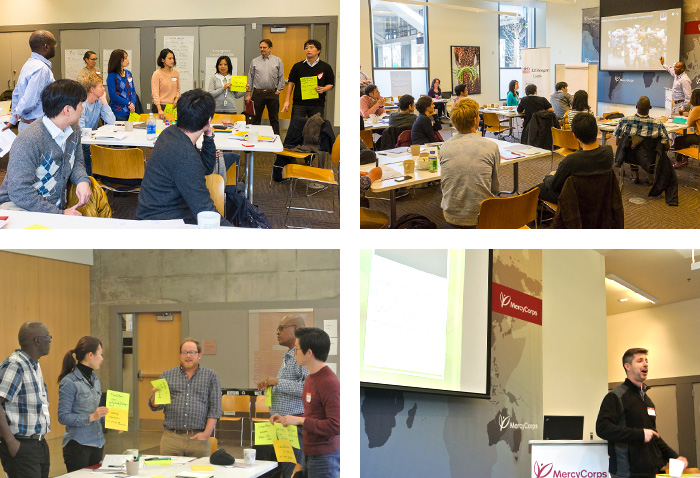
How You May Feel When You are Deployed: Extremely Stressed and Confused
While the morning session went through lots of informative lectures, the afternoon session was filled with practical training; it included "Sphere Review" and "First Humanitarian Exercise."
I won't go explaining the details of what the Sphere Project(*1), Handbook, and standards are here; you should rather check out the official website: http://www.sphereproject.org/. For those that have no idea, I would sum up Sphere as, "Common understandings of what humanitarian actors should take into consideration and how we should act upon when assisting those that suffered from disasters, conflicts and crises, both nature and human-made." It seemed most of the participants had basic understandings of the standards so we had a brief review of the contents of the Handbook by answering some quizzes. Some participants responded instantly to all questions without even touching the Handbook - kudos to those!

As for me, though I was familiar with the standards in the WASH (Water, Sanitation and Hygiene) sector, I had close to zero knowledge in the other sectors or areas. I figured I should have comprehensive understanding of the standards and indicators of Sphere in order to not overlook desperate needs that should be met by the most vulnerable affected population. On the other hand, a conflicted thought was telling me that standards are standards; they are there for you to have basic understandings and tell you the minimum dos and don'ts. The context may be too disastrous or chaotic that none of the standards can be applied to. So my takeaway of the session was: Know the basics of Sphere, carefully analyze the context, and don't be afraid to be flexible.
Up next was the First Humanitarian Exercise (and yes, we had the second one a couple of days later), and oh boy, how uncoordinated our team was!
The session basically was a simulation training in which participants were allowed to apply the skills and knowledge learnt during day one and two--Humanitarian Principles, personal safety and security, program cycle and assessment, the Cluster System and Sphere. The trainers broke the participants up into four teams (virtual NGOs) which respectively had their expertise in the Livelihood, Education, WASH, Health sector, and everyone was deployed to Donetsk People's Republic of Eastern Ukraine do address the humanitarian needs. We were to organize our team, collect information from different actors (role-played by the trainers), and eventually understand the general context of the area you are in.

So with close to zero information of the context, my three teammates included in the Livelihood NGO rushed in the room, which had a signboard "Kiev" and started the conversation by, "So...who are we?" Though the piece of paper that explained about this simulation training was handed out the day before, it seemed that none of us had done any home works such as doing research on Ukraine or the Livelihood sector, knowing about our NGO, etc. In the room, there were 8-10 role-players sitting, so we figured we should check out UNOCHA (UN Office for Coordination of Humanitarian Affairs) to have a grasp of the entire picture of the region, the affected household, and others who seemed to have information on livelihood, protection, food and shelter. But to our disappointment, the information that UNOCHA had was extensively less than we had expected, so at that point, we had to change directions and approach as many organizations as possible to get the entire picture. After a while, one of the trainers announced that out of the four NGOs only one person was allowed to report about our findings. I don't remember how that person was decided but I remember having two thoughts in mind: Nope, I'm not the one, I'm too confused. But hey, it's not fair having one NGO represent the rest.
At the end that person did an amazing job to try organizing the information gathered from all and not forgetting to advocate that we need more information to assess the detailed needs. I remember what the main facilitator leading the session commented as advices and how I thought about each one:
1. Know your teammates (Hmm, did not do.)
2. Pick a leader, and decide the roles/responsibilities of each teammate. (Well, we kind of did, but not really.)
3. You don't have too much time, break up your team and get information efficiently. (We moved together until the last minute...well to be on the bright side, we avoided collecting biased information by involving everyone.)
4. Think carefully about what you ask each organization within your team. (Again, we kind of did, but not really.)
5. Coordinate with other NGOs (Nope, not at all.)
The only fairly positive action we took was to listen carefully about what the affected household had to say.

What I remember the most was the stress and confusion I felt during the training. So I can say that I was able to successfully meet the expectation that the facilitator had, "We wanted you to feel the stress and confusion." And we know the real world of post-disaster or conflict is much more chaotic. We need to deal with this stress and confusion while trying to achieve the best.
My three takeaways of this Humanitarian Exercise were:
1. Deal with the stress and confusion. They will be there no matter what.
2. Know about everything as much as possible before you reach the spot.
3. Don't forget about coordination. You can't do everything by yourself.
Arisa Nishida
JEN
*1 The Sphere Project (Sphere):
In the aim of improving the quality of humanitarian agencies' actions during disaster response and to be held accountable for them, a group of NGOs and the International Red Cross and Red Crescent Movement established a set of standards in core areas of humanitarian assistance being based on the Humanitarian Charter.
http://www.sphereproject.org/about/
Sessions for the Afternoon in Day 2:
- Intro to Common Sector Specialties in Sphere
- First Humanitarian Exercise (Simulation)
Importance of Taking Protection and Do No Harm Concept into Consideration for Emergency Assistant Project
The morning in the 3rd day of the workshop focused on Protection and Do No Harm.
Generally speaking, people who work on emergency projects tend to focus on them on certain sectors such as Education, WASH (Water, Sanitation and Hygiene), Shelter, and Food, however, there is one common topic which should be considered for all the projects and that is the idea of "Protection". Protection means that each project should be planned thoroughly so that the relief activity is actually reaching to the most vulnerable people who need it the most and also the relief activity is not causing side-effects which may not be so easy to foresee if not planned carefully. One such example where Protection idea is crucial is when constructing latrine in an emergency situation since people tend to go alone to the toilet even at night, therefore if the latrine is placed far away from residence, rape may take place there. Therefore, locations for the latrines should be planned carefully. Also another example would be sometime PWDs (Persons with Disabilities) and single women household tend to have tough time lining up for water or food. Therefore, it should be taken into account when designing the project. These kinds of topics were explained thoroughly by Protection expert from Mercy Corps.

After that session, another important idea of "Do No Harm" was introduced with examples. Big point in the session was the idea of dividers (What divides societies) and connectors (What connects societies). When a crisis is caused by civil war, there is usually a risk that helping a particular sector of people makes the implementation organization to be perceived politically biased and this may cause sense of unfairness among people and may divide the society. Also, to unite society, sometimes it is useful to use a pre-established system in the society such as the power of village leader of chieftain and working through them sometimes cause society to understand humanitarian activities more smoothly.

Both the sessions covered extremely important topics in the humanitarian context which should be applied in emergency phase projects and something that all NGO workers should know; therefore, it was extremely fruitful morning.
Daijo Tsuchikawa
Association for Aid and Relief, Japan (AAR Japan)
Sessions for the Morning in Day 3:
- Review of Day 2
- Understanding the General Principles of Protection
- Analyzing the Context for Connectors and Dividers (Do No Harm)
Next:"The Day 3 Afternoon: There's Always a Room for Improvement & Innovation - Takako Shimizu, PWJ"
There's Always a Room for Improvement & Innovation
In the afternoon, we covered the topics of beneficiary participation presented and security management.
It was my first time knowing of the Good Enough Guide(*1) and how we can incorporate such a tool in our project implementation.

Most of the participants may have experience from security trainings, yet, the ideas of acceptance by community, protection through good institutional management, and deterrence through alliances for greater power were still refreshing to me.

After today's sessions, we enjoyed the gallery walk with Mercy Corp's technical staff of "Governance and Partnerships," "Electronic Cash Transferring," and "Energy and Environment," which was another inspiring event not just because of their passion and expertise but because of their culture for innovation.

Takako Shimizu
Peace Winds Japan (PWJ)
*1 The Good Enough Guide (Impact Measurement and Accountability in Emergencies: The Good Enough Guide):
Practical wisdom for the busy field workers on how to be accountable to disaster affected communities and measure program impact in an emergency.
English ver.:
http://www.alnap.org/resource/8406
Japanese ver.:
http://www.japanplatform.org/contents/NGO-leadership/lib/201503_the_good_enough_guide.pdf
Sessions for the Afternoon in Day 3:
- Protection in Programming and Gaining Beneficiary Perspectives
- Acceptance in Security
Next:"The Day 4 Morning: How to Act Under the Complex Situation as NGO - Nami Iwashita, ICAN"
How to Act Under the Complex Situation as NGO
In the morning of Day 4, we had three lectures: "Reduced Access Programming", "Negotiation Skill", and "Measuring & Learning in Emergencies".
In the first lecture "Reduced Access Programming", we learned how to deliver impact in politically and economically constrained environments with reduced access.
In the constrained environment such as Iraq and Syria, security management is crucial as well as humanitarian project itself compared with those in non-constrained areas where the government is functioned and access is available. Framework to gain access for humanitarian action and 12 principles such as "Keep it simple" and "Question whether you have to do it all" in constrained environment were introduced in the lecture.
The second lecture "Negotiation Skill" talked about the negotiation with non-state armed group.
In humanitarian response, it is important to build relationship not only with government but also with non-state armed groups.
Negotiation skill is needed for humanitarian responders. For example, NGO has to show non-state armed groups clearly that they do not support government politically.
In the lecture, the facilitator listed elements of negotiation with non-state armed groups, such as, to build relationships by two-way communication, to understand their interests and provide options, then to find the legitimacy and get commitment from them.
In the last session, measuring impact in emergency was discussed.
Impacts of the humanitarian response are essential for several actors including beneficiaries, aid agencies, donors, and national governments.
Mercy Corps uses the data of "number of households or individuals receiving emergency relief services showing change in assessed conditions" and "number of people receiving emergency relief services" as indicators.
Besides, we learned several other methods for measurement. Using social media such as Twitter seemed interesting to me when measuring the impact.
Nami Iwashita
International Children's Action Network (ICAN)
Sessions for the Morning in Day 4:
- Review of Day 3
- Reduced Access Programming
- Skills for Negotiating Access in Humanitarian Emergencies and Complex Crises
- Measuring and Learning in Emergencies
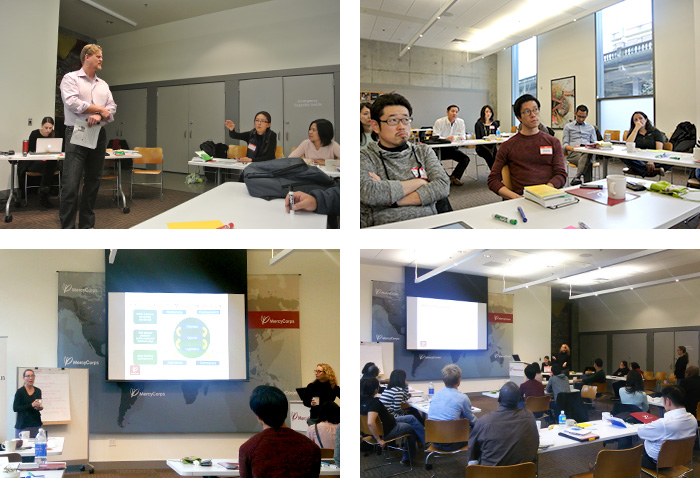
Next:"The Day 4 Afternoon: Organization That Earns Respect in Civil Society - Kyosuke Imamura, BAJ"
Organization That Earns Respect in Civil Society
In the afternoon of the fourth day, at first, we received a presentation on Resilience. Resilience is the capacity of communities in complex socio-ecological systems to learn, cope, adapt, and transform in the face of shocks and stresses. It is important to aid with the long-term vision so that people can build community resilience. Then, they become less vulnerable to shocks and stresses and more capable of recovery.

Following the session of Resilience, we had a special panel with five rich-experienced Mercy Corp staff, and they answered various questions from participants. We were able to learn their valuable experience, for example, how to find a local staff in a country without the base of the organization when an emergency happens such as a disaster, how to stay motivated as a humanitarian worker, and how to coordinate between field offices and headquarters when their opinions are different.

After we went through all the fourth day sessions, we were invited to the Happy Hour of Mercy Corps HQ, which is held regularly for volunteers and people from around the community to gather and mingle. Mercy Corps HQ has a lot of volunteers, and a man, who has worked more than 500 hours for 6 months as a volunteer, said, "I have time after retirement, and I respect Mercy Corps' activities, so I do volunteer work here." I found that it is really important for NGO to be recognized and supported by the civil society, and Mercy Corps earns respect in civil society due to its daily activity by the competent employees such as panelists in the afternoon.
Kyosuke Imamura
Bridge Asia Japan (BAJ)
Sessions for the Afternoon in Day 4:
- Resilience in Humanitarian Programming
- PANEL
Last Day of Training
On the day 5, we did the "Humanitarian Exercise" which required all the skills and knowledge we gained through this week, and followed the "First Humanitarian Exercise" held in the afternoon of Day 2 (go to the previous report if you'd like to grasp the detail) . It was exciting that the real ongoing conflict situation was given in the simulation. We were expected to design a humanitarian response program after assessing the situation and needs of affected populations through coordination with other actors who had various interests. Understanding all the skills and principles is very different from applying them to the reality. I was not sure what to do first. But after discussion with team mates over protection, security and other issues, I realized that we were actually applying principles to the reality. Our program turned out to provide hygiene kits to the affected people. It was very practical experience.
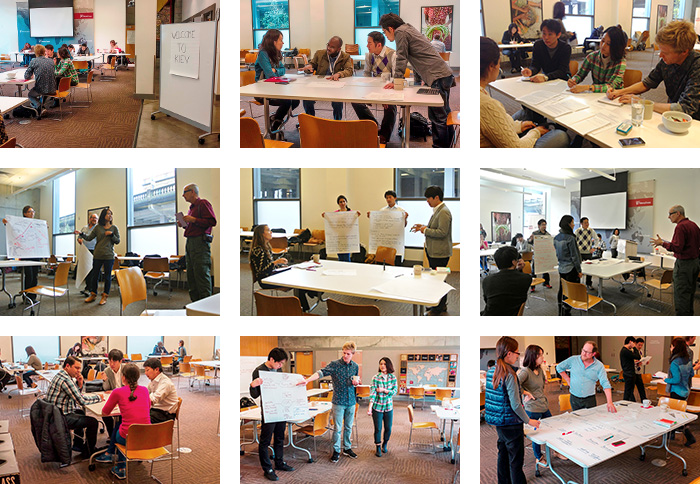
Susumu Tada
Japan Association for Refugees (JAR)
Sessions for the Day 5:
- Review of Day 4
- Humanitarian Exercise (Simulation continued from the Day 2)
Class of HRW 2015 (Humanitarian Response Workshop 2015) Completes the Week!
The workshop which started on 30th November to 4th December ended with actionable feedback out of the final simulation training. All the participants acquired nothing but rewarding feeling, and as thus you can see a good look on everyone.
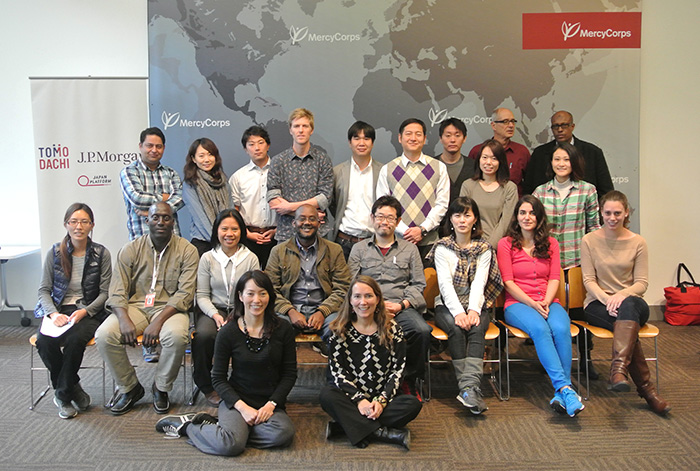
This workshop attracted a total of about 15 participants from Japanese NGOs (AAR Japan, BAJ, HuMA, ICAN, JAR, JEN, and PWJ) and Mercy Corps' staff from HQ in Portland, branch offices from Washington D.C. and UK. As for facilitators, richly experienced head facilitator has taken a lead to design and call enthusiastic co-facilitators from around the globe such as: Uganda, Somalia, Nigeria, Niger, Jakarta, Kashmir, and so forth. They are all Mercy Corps' staff on active service, who have extensive experience and knowledge on humanitarian response. Thanks to their well-elaborated sessions and many hands-on exercises, participants could continuously explore their own experiences and those of others. Finally, in this non-defensive workshop environment, every participant developed the feeling, "Despite the situation in which each NGO faces, we are all in the same boat of 'supporting those affected by disasters.'"

Upon return, some participants raised the most important thing s/he acquired from the week as below:
"To protect life with dignity."
"The situation of humanitarian response is really chaotic, so it is very important to make sure if all stakeholders concerned including beneficiaries are well-informed."
"Humanitarian response requires a lot of coordination with beneficiary, other NGO, government and many other entities."
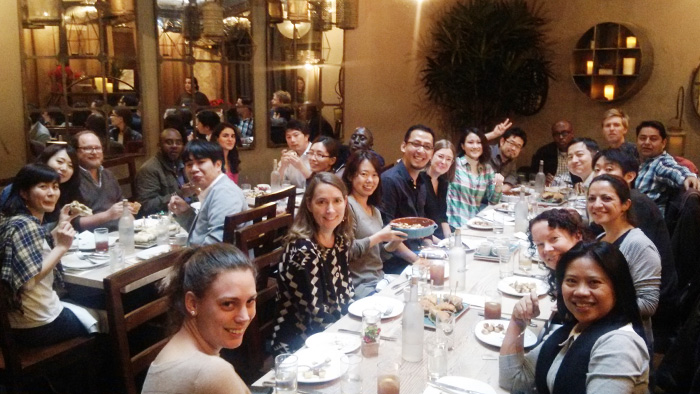
Hopefully, all the skills, guidelines, tools, and awareness of their own strength and weakness by sharing each other's experiences have been disseminated to their comrades in each organization. And in the future crisis, these new-born leaders must prove the benefit of this fruitful 5-day workshop!!
Yuko Taniguchi
Japan Platform (JPF)
In partnership with Mercy Corps under the TOMODACHI NGO Leadership Program, JPF will be holding a week-long humanitarian workshop from November 30th to December 4th at Mercy Corps headquarters in Portland, Oregon. The first year's workshop (Oct 2013*) was hosted by Mercy Corps at its headquarters. The second year's (Oct 2014**) was in Japan hosted by Japan Platform. This year, we will bring the workshop back to Portland again. Around 10 NGO member staff from Japan will participate in the workshop along with an equal number of Mercy Corps staff in addition to NGO guests from Taiwan, Korea and China - for a total of 30 participants. As future leaders, participants will gain knowledge and hands-on learning experience in 5-7 key themes in order to implement more effective activities in disaster, conflict and other humanitarian situations. Participants will also acquire new findings on the humanitarian subjects in other countries and broaden networks as well.
For further outline (only in Japanese) of past workshops, please click on the following links.
* The first year's (Oct 2013) http://www.japanplatform.org/contents/NGO-leadership/20130922.html
** The second year's (Oct 2014) http://www.japanplatform.org/info/2014/07/181824.html
Workshop Brief
| Date | Monday, November 30 - Friday, December 4, 2015 |
|---|---|
| Location | Mercy Corps HQ (Portland, OR, U.S.A) |
| Language | English |
| Topics |
|



